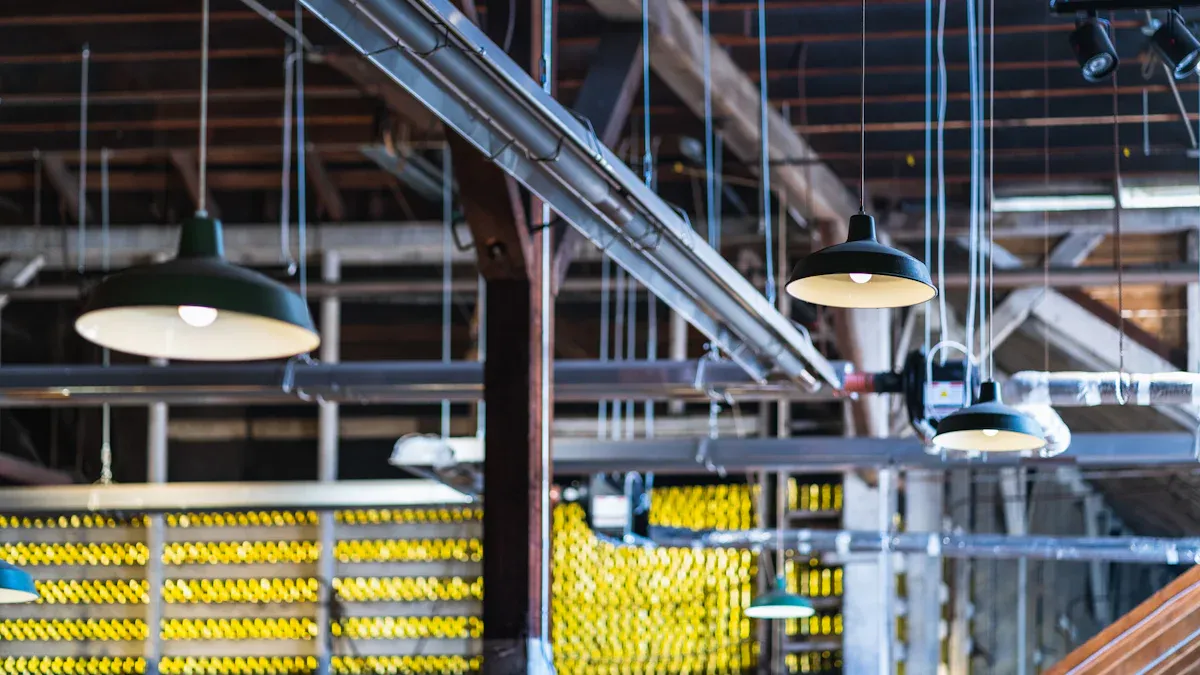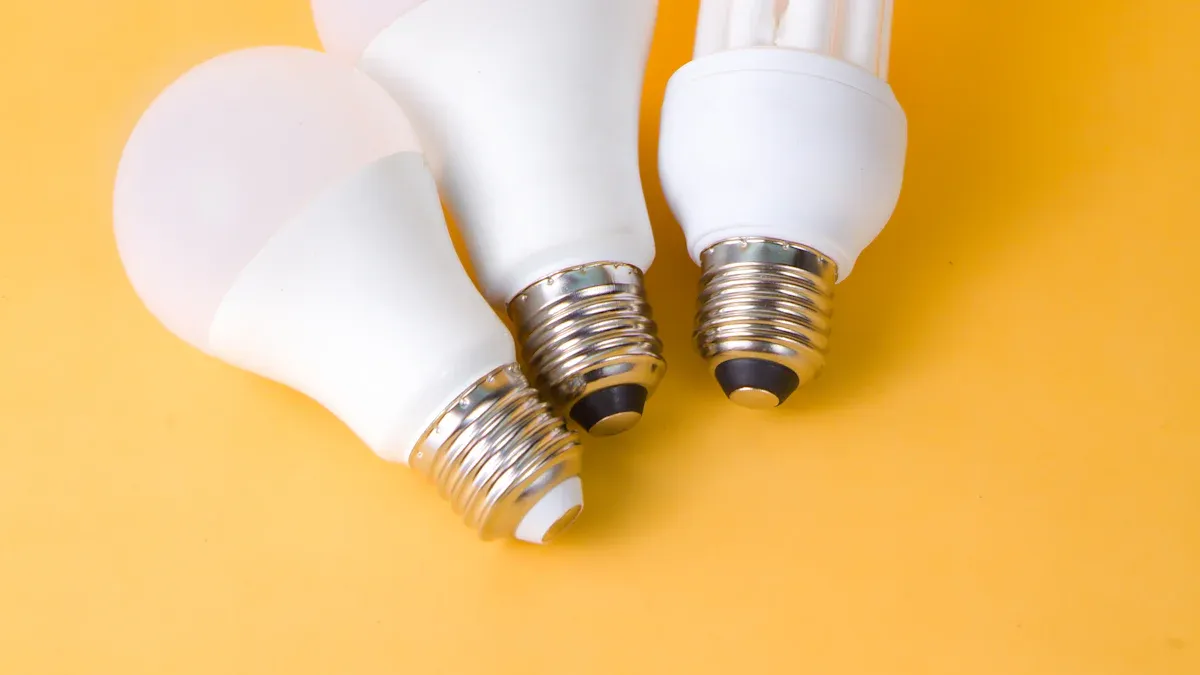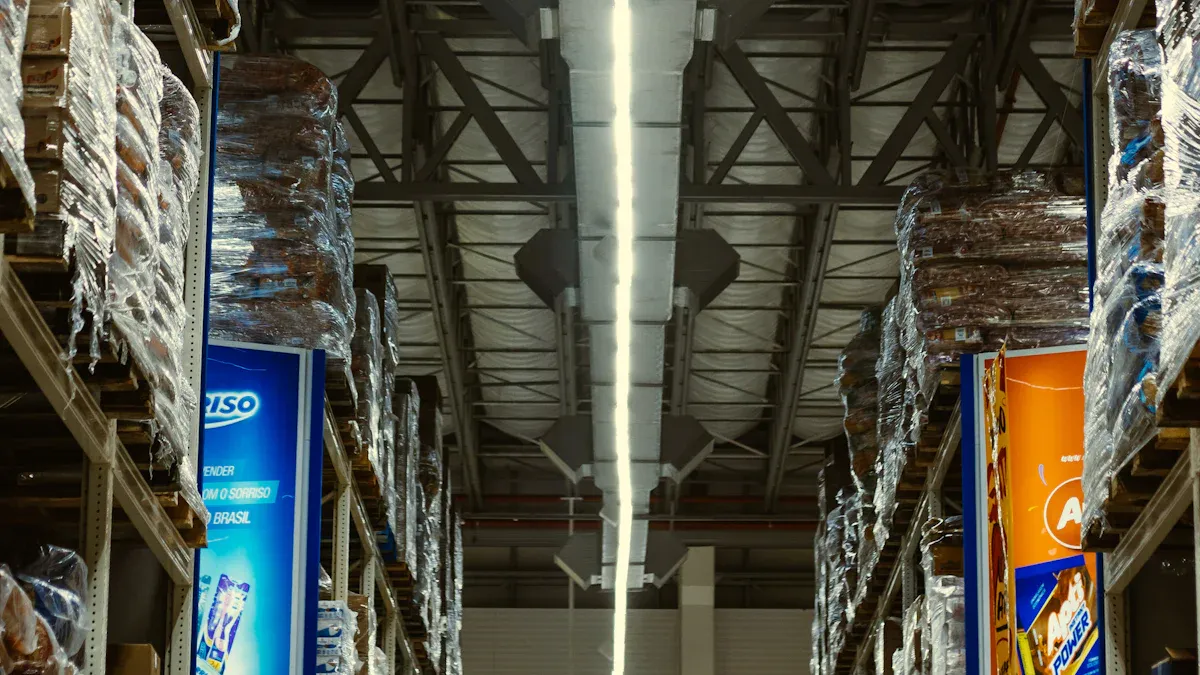
You can find many types of Industrial LED Lights for different spaces. High bay lights work well for tall areas. Low bay lights fit shorter ceilings. Flood lights give wide coverage. Linear fixtures, panel lights, and wall packs suit Workshop Lighting or Garage Lights. Choosing the right option boosts safety and saves energy.
Key Takeaways
- Choose the right industrial LED lights based on your space height and needs to improve safety and save energy.
- Industrial LED lights last long, use less power, and reduce maintenance costs, helping you save money and protect the environment.
- Regularly inspect, clean, and maintain your LED lights to keep them bright, safe, and working efficiently.
Main Types of Industrial LED Lights

High Bay LED Lights
You use high bay LED lights in spaces with tall ceilings, usually 20 feet or higher. These lights work best in warehouses, factories, and gymnasiums. High bay lights provide bright, even light across large areas. You can choose from round (UFO) or linear shapes. High bay LED lights help you reduce shadows and improve visibility for workers.
Tip: If your facility has high ceilings, high bay lights offer the best coverage and energy savings.
Low Bay LED Lights
Low bay LED lights fit areas with ceilings between 12 and 20 feet. You often see these lights in workshops, garages, and small warehouses. Low bay lights give you focused light for tasks and storage. They use less power than high bay lights because they do not need to shine as far.
LED Flood Lights
LED flood lights give you wide, powerful beams. You use them to light up outdoor spaces, parking lots, and building exteriors. Flood lights help you boost security and safety at night. You can also use them for loading docks or sports fields. Many flood lights have adjustable heads so you can aim the light where you need it most.
LED Linear Fixtures
LED linear fixtures have a long, narrow shape. You install them in rows for even lighting in aisles, assembly lines, or production areas. These fixtures help you reduce dark spots and create a clean look. You can mount them on ceilings or suspend them with chains.
- Common uses for LED linear fixtures:
- Warehouses
- Supermarkets
- Manufacturing plants
LED Panel Lights
LED panel lights give you soft, glare-free light. You often see them in offices, clean rooms, and laboratories. These lights fit into drop ceilings and provide a modern look. Panel lights help you reduce eye strain and create a comfortable work environment.
LED Wall Packs
LED wall packs mount on the outside walls of buildings. You use them to light up walkways, entrances, and loading zones. Wall packs help you keep your facility safe by reducing dark areas around doors and windows. Many wall packs have dusk-to-dawn sensors for automatic operation.
LED Vapor Tight Fixtures
LED vapor tight fixtures protect against dust, moisture, and chemicals. You use these lights in car washes, food processing plants, and cold storage rooms. The sealed design keeps out water and dirt, so the lights last longer. Vapor tight fixtures help you meet safety standards in tough environments.
Note: Choose vapor tight fixtures if your facility has wet or dusty conditions.
LED Explosion Proof Lights
LED explosion proof lights keep you safe in hazardous locations. You need these lights in areas with flammable gases, dust, or chemicals. The strong housing prevents sparks from escaping and causing fires. Explosion proof lights meet strict safety codes for oil refineries, chemical plants, and mines.
LED Strip Lights
LED strip lights are flexible and easy to install. You use them for accent lighting, under shelves, or inside machinery. Strip lights help you highlight work areas or add extra light in tight spaces. You can cut them to fit almost any length.
LED Heavy Equipment Lights
LED heavy equipment lights mount on forklifts, cranes, and other machines. These lights help operators see better and avoid accidents. You can choose from spot, flood, or combination beams. Heavy equipment lights work well in harsh conditions and last longer than old halogen bulbs.
Using the right type of Industrial LED Lights helps you improve safety, save energy, and lower maintenance costs. Each type fits a specific need in your facility.
Key Benefits of Industrial LED Lights

Energy Efficiency
You save energy when you switch to Industrial LED Lights. These lights use less power than older lighting systems. You can lower your electricity bills and reduce wasted energy. Many factories and warehouses choose LEDs because they help meet energy-saving goals.
Long Lifespan
Industrial LED Lights last much longer than traditional bulbs. You do not need to replace them as often. Some LED lights can work for over 50,000 hours. This long life means fewer interruptions in your work areas.
Improved Safety
Bright and even lighting helps you see better. Good lighting reduces the risk of accidents and injuries. Industrial LED Lights turn on instantly, so you always have full light when you need it. You can trust these lights in emergency situations.
Tip: Better lighting can help you spot hazards before they cause problems.
Reduced Maintenance Costs
You spend less time and money on maintenance with LED lights. Fewer bulb changes mean less work for your staff. You also avoid the cost of buying replacement bulbs often.
Environmental Impact
LED lights help protect the environment. They use less energy and produce less heat. Many LEDs do not contain harmful materials like mercury. You help reduce your facility’s carbon footprint when you choose LED lighting.
How to Choose the Right Industrial LED Lights for Your Facility
Assessing Your Application and Environment
Start by looking at where you need lighting. Think about the size of your space and what activities happen there. For example, a warehouse needs different lighting than a food processing plant. Check if your area has dust, moisture, or chemicals. This helps you pick lights that can handle tough conditions.
Determining Required Brightness and Coverage
You need to know how bright your space should be. Measure the area and decide how much light each part needs. Use a simple table to plan:
| Area Type | Suggested Brightness (lux) |
|---|---|
| Warehouse | 100-200 |
| Workshop | 300-500 |
| Office | 300-500 |
Choose lights that give even coverage. Avoid dark spots or glare.
Evaluating Energy Efficiency and Cost Savings
Look for lights that use less power but still give strong light. Energy-efficient Industrial LED Lights help you save money on electricity bills. Check the wattage and compare it to older lights. Lower wattage with the same brightness means more savings.
Considering Safety Ratings and Compliance
Make sure your lights meet safety rules. Look for labels like UL or DLC. These show the lights passed safety tests. If your area has special risks, check for explosion-proof or vapor-tight ratings.
Tip: Always check local codes before you buy new lights.
Factoring in Installation and Maintenance Needs
Pick lights that are easy to install and keep clean. Some fixtures need special tools or skills. Choose options that let you change parts quickly. This saves time and keeps your facility running smoothly.
Safety and Compliance Standards for Industrial LED Lights
OSHA Lighting Requirements
You must follow OSHA rules when you install lighting in your facility. OSHA sets minimum light levels for different work areas. For example, warehouses need at least 10 foot-candles, while workshops need 30 foot-candles. You can use a light meter to check if your Industrial LED Lights meet these standards. Good lighting helps you prevent accidents and keeps your team safe.
UL and DLC Certifications
You should look for UL and DLC labels on your lighting products. UL stands for Underwriters Laboratories. This group tests lights for safety. DLC means DesignLights Consortium. DLC checks if lights save energy and work well. When you choose lights with these certifications, you know they meet high standards.
Tip: Certified lights often last longer and use less power.
IP and IK Ratings
IP and IK ratings tell you how tough your lights are. IP ratings show if a light can block dust or water. For example, IP65 means the light is dust-tight and can handle water jets. IK ratings measure how much impact a light can take. Higher numbers mean stronger protection. You should check these ratings if your facility has harsh conditions.
Hazardous Location Classifications
Some areas have flammable gases or dust. You need special lights in these places. Hazardous location classifications tell you which lights are safe to use. Look for Class I, II, or III labels. These show the light can work safely in risky spots. Always match the light to the hazard in your area.
Maintenance Tips for Industrial LED Lights
Routine Inspection and Cleaning
You should check your lights on a regular schedule. Look for dust, dirt, or moisture on the fixtures. Clean the covers and lenses with a soft cloth and a mild cleaner. Make sure you turn off the power before you start cleaning. If you see any loose wires or broken parts, fix them right away. Keeping your lights clean helps them shine brighter and last longer.
Tip: Set a reminder to inspect your lights every three months. This habit can prevent bigger problems later.
Troubleshooting Common Issues
Sometimes, you may notice flickering, dimming, or lights that do not turn on. First, check the power supply and make sure all connections are tight. Replace any damaged wires or connectors. If a light still does not work, try swapping it with a working one to see if the problem is with the fixture or the bulb. Use a simple checklist:
- Check power source
- Inspect wiring
- Test with a new bulb
- Look for signs of water damage
If you cannot fix the issue, contact a qualified electrician.
Planning for Upgrades and Replacements
Plan ahead for when your lights reach the end of their lifespan. Keep a record of installation dates and hours of use. When you notice lights getting dim or failing, order replacements before they all go out. Upgrading to newer models can save energy and improve lighting quality. You can also look for features like smart controls or higher efficiency.
Regular maintenance keeps your facility safe and your lighting system working at its best.
You have many lighting options for your facility. Each type offers unique benefits. Choose lights that fit your space and tasks. Check safety ratings before you buy. Clean and inspect fixtures often. Smart choices help you save energy, improve safety, and keep your workplace bright.
FAQ
How long do industrial LED lights last?
Most industrial LED lights last 50,000 hours or more. You can use them for years before you need to replace them.
Can you use LED lights in cold storage areas?
Yes, you can use LED lights in cold storage. LEDs work well in low temperatures and give you bright, reliable light.
Do LED lights need special maintenance?
You do not need much maintenance. Just clean the fixtures and check for damage. Replace any broken parts right away.
Tip: Regular cleaning helps your lights stay bright and last longer.
By: Grace
Tel: +8613906602845
E-mail: grace@yunshengnb.com
Youtube: Yunsheng
TikTok: Yunsheng
Facebook: Yunsheng
Post time: Jul-21-2025
